Oppskåke
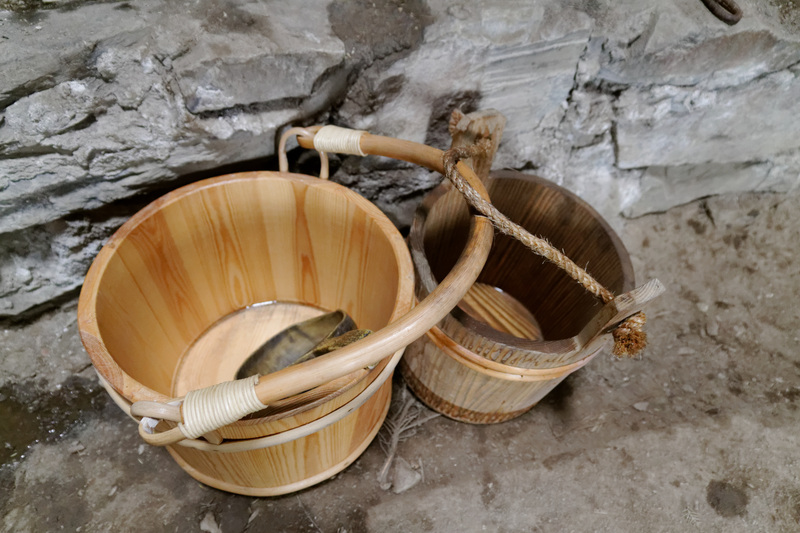
Water buckets, Norwegian Museum of Cultural History |
In older times there were a whole host of detailed social customs around the drinking of beer, but the only one I'm aware of that has survived into the present day is oppskåka. Oppskåke is a party for friends and neighbours held after primary fermentation, when the beer is transferred from the fermenter to the cask. When Terje invited me to brew with him, he also invited me to stay until oppskåka, since that was only 48 hours after the brewing.
The name, by the way, literally means "to shake up" (å skaka opp), and refers to the racking. Oppskåka is the definite form, oppskåke the indefinite. If that's not clear, oppskåka = the oppskåke.
In the old days, people would see when a particular farm was brewing. They would note the tuns being laid in the brook, the smoke from the brewhouse, and so on. And since the fermentation time was usually the same every time, they knew what evening to show up in the brewhouse for the party.
People would find seats in the brewhouse wherever they could, and the brewer would pour the beer directly from the fermenter into a wooden bowl. The bowl would go round from drinker to drinker, and since every person present was a brewer, they would comment on the beer.
Of course, to tell someone straight to their face that their beer is bad is difficult, so there were many customs around this. Some places people would discuss the beer in direct terms. "Could use more hops, I think". Or: "I think you let it ferment too long." And so on. Other places there were set phrases that people would use to comment on the beer.
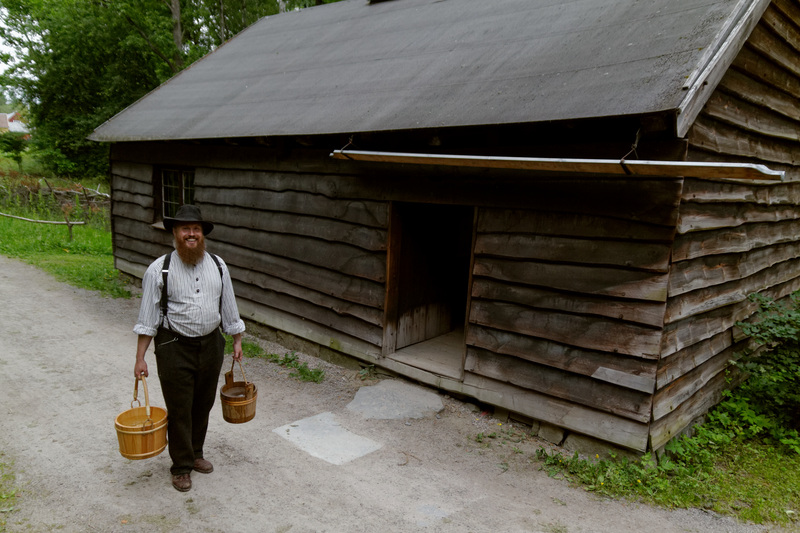
Lars Olav Muren carrying water, Norwegian Museum of Cultural History |
The brewer might start it off, saying: "Oh, you can safely drink the beer. I've tasted it enough to know it's not bad." It was a fixed phrase, but not an empty one, because fungus on the grain might make it bad, so that the beer would make anyone who drank it vomit. This was one reason why brewers would taste the wort the moment it came off the strainer, so that they would know if the beer would make people sick. Since they were making the malts themselves, this was the only possible quality assurance.
His neighbours might then reply "oh, I can tell the well was far off when you made this. Either that or you were too lazy to carry much water." Implicitly: this is strong and good beer. If they said "I can tell you live near a great lake," that implied the opposite, and was almost an insult.
Some places, the visitors would make no comment on the beer while in the brewhouse. Late that night, leaving the brewhouse, they would stop on the way home and scream. The louder the screams, the better the beer. In some areas people had fixed places where they'd always stop to do the screaming. If the beer was poor the screaming would be half-hearted at best.
In parts of western Norway, inviting all the neighbours was an inescapable duty, no matter what you might think of your neighbour. After a few beers this might lead to fighting, and sometimes did. Other places, the custom was not as formal, but anyone who dropped by would be invited to taste the beer. In these places, some of the people dropping by on "necessary" errands were often suspected of having timed their visit carefully.
The full-on formal oppskåke seems to have been common only in western Norway, roughly from Kristiansand to Molde. The farmhouse ale survey has questions about it, but some people even in western Norway deny knowledge of the formal party. Yet the ethnographic literature is full of descriptions of the ritual. What that really means I'm not sure. In eastern Norway it was more common to send a boy round to nearby farms with a bowl of the new beer. This was called "skokubolle" (shake bowl).
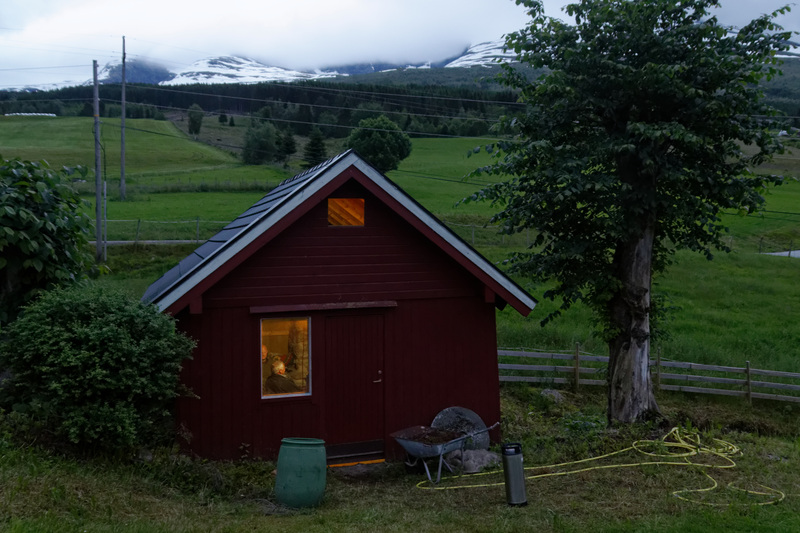
Party in the brewhouse, Innvik |
When we visited Terje's uncle Rasmus I asked him if he'd ever been told that he "lived by a large lake" (he literally does). He laughed, and said nobody had ever told him that. In fact, one of the first times he brewed, at the oppskåke, one of the older brewers had told him it was "damn annoying to see a young whippersnapper like you brew better beer than us oldtimers (det va da som fan at en ungstrik som deg sku' bryggje betre øl enn oss gamlekarane)". Rasmus then laughed again. Clearly the memory still warmed seven decades later.
I'd read a lot about oppskåke, but I had never actually been to one. From what I can tell, not many people have. The reason there are no photos of one above is that as far as I know, hardly any exist. I know one book that has a single photo, and a movie (not publicly available) that shows it. That's all. Literally everything. So, as you can imagine, I was pretty chuffed to actually be present for this rare and famous ritual.
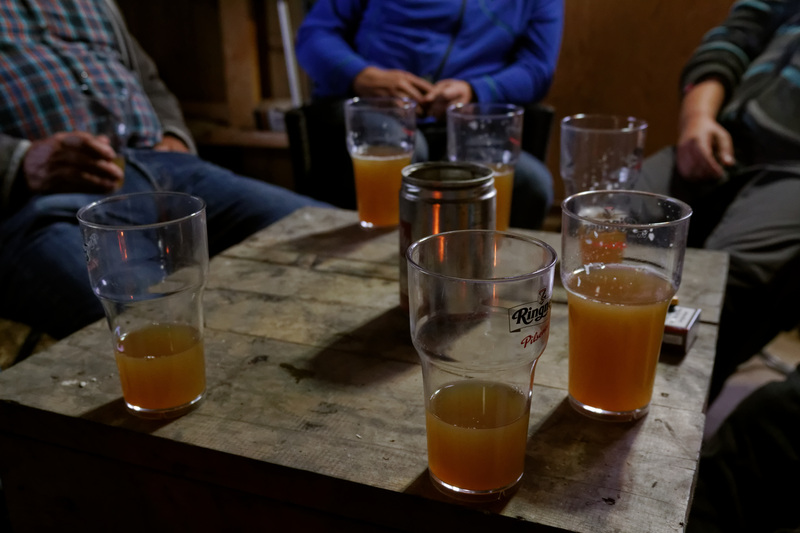
Fresh raw ale |
It was kind of odd in several ways. For one thing, we were not drinking beer in a pub, but in a rough, old wooden building. The table was the one we'd put the strainer on during the brewing. The chairs were just simple plastic folding chairs, and the glasses were also plastic. People had their jackets on, because it was cold in the brewhouse. The background noise was not music, but the sound of the brook running through the brewhouse.
It was only 48 hours since we'd finished brewing the beer, but fermentation had already calmed down, and the foam on the beer had shrunk. Terje served the beer with a steel ladle right out of the fermenter and into the glasses. Served this way the beer was flat, with hardly any carbonation, and sweet, with citrus, earth, and pea flavours. Rather different from the matured beer, but good. I could feel the alcohol warming in my mouth. Even this early it was a great beer, almost too drinkable at 7.5%.

Conversation in full flow |
Some of the people at the oppskåke were there for obvious reasons. Terje's father-in-law was there because he has the job of cleaning, drying, and freezing the kveik. Roger was there because he was with us when we brewed. Roger's father was there because he used to brew with Terje. The farmer who owned the brewhouse was there because we borrowed his brewhouse. The last two people probably had some reason for being invited, too, but I never found out what it was.
After people had a couple of glasses the conversation really got going. I remember discussions of the laws on energy production (there's lots of waterfalls and steep streams in the area, which people use for small power plants), cherry growing, local politics, and so on. After another couple of glasses they turned to stories, and these grew wilder as the evening went on.
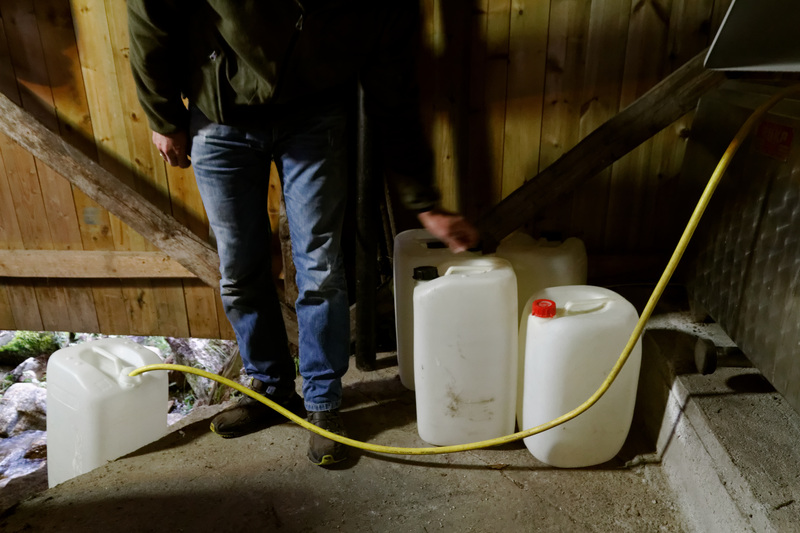
Racking |
Terje brews 150 liter batches, so people had brought big white plastic containers for the beer. The beer was racked off with a siphon, but Terje started the process a little too early. After the fermenter was empty one of the guys wanted another glass. That problem was solved by pouring from one of the big kegs.

Pouring |
In the end, we had to wrap it up, as the others had to go to work the next day, and I had an early flight home. I flew home with two precious bottles of Hornindal ale in my suitcase.

Midnight |
Similar posts
Brewing raw ale in Hornindal
I tried a Hornindal raw ale at a tasting with friends, and was blown away, for two reasons
Read | 2015-12-26 11:35
Brewing in Hardanger
Hardanger in western Norway used to be famous for its traditional culture in general, and also for its farmhouse ale
Read | 2018-06-02 11:44
Brewing in Morgedal
The farmhouse survey showed that brewing in Telemark was still alive in the 1950s, but for a long time I thought it had died out
Read | 2015-10-29 14:00
Comments
merryn dineley - 2016-02-14 12:20:56
That was great fun to read. These sound like the best parties.
I particularly like the idea of screaming about how good, or not so good, the beer was as you make your way home. I can imagine the norsemen and women doing this, as they went home to their longhouse, though of course there is no way of knowing whether this tradition goes back that far. I hope that it does!
Lars Marius - 2016-02-14 12:25:39
@Merryn: Thank you. Some of the beer drinking customs I haven't written about yet definitely go back to viking times and beyond. This particular one I am not sure about. I can trace it back to the early 1800s, but no further. So I can't say anything for certain.
Martynas - 2016-02-14 13:55:53
Beautiful!:) Interestingly (and not surprising after so many other similarities in brewing tradition) we have a very similar custom in Lithuania - it's called "koštuvės" and again, literal translation is "racking" beer (from "košti", transl. to rack). Typically it would be closest neighbours that would be invited to koštuvės, and there would natrally be discussions about the young beer quality among other topics. I understand that there might also be a special "code" of speaking about it, and straight-foward criticism was not encouraged. The word explanation in the term dictionary also mentions that the same custom was typical in beekeeping when racking (term?) honey. It also mentions the feast being organised; and that the freshly racked beer (the beer would be called "koštuvių" then) would be taken to the neighbours instead of inviting them over home. The neighbour would be expected to do the same - bring or invite for "koštuvių" when he'd rack his beer. The tradition started fading in the late XX century with a trend of relocating from villages to sparsely located country houses/farmhouses. Never heard of screaming tradition unfortunately. On the other hand, we might've called it "singing" which was a very popular combination to beer consumption:)
Lars Marius - 2016-02-14 14:06:30
@Martynas: Thank you for pointing that out! I can't believe I missed it. I see now it's described in Per barzda varvejo with a reference to a 15th century source. Well, Merryn, there you go. The custom clearly is ancient after all.
Roger - 2016-02-14 15:50:26
One thing Terje told me about "screaming the beer" (brøle ølet), you might find interesting. If you e.g. take the beer on a montain trip it might get cold on the way. And cold konnøl is as we know, is no good. Then the old guys used to pour the beer in a hot pot to warm it. The beer would then make a screaming noise, hence the expression, screaming the beer.
Keith - 2016-02-14 21:21:52
Great blog. I've very much enjoyed reading about some of the culture around brewing in your part of the world.
I'm in Canada, another place with cold winters. Time to start up an Oppskåke with my neighbours. I already share the beer - it would be fun to have them scream about it. And I'm a good way front the river.
Thanks
Keith
Kenny Carlsson - 2016-02-15 06:09:29
Today I found a record of screaming in relations to brewing in Sweden as well. At URL: http://www.murberget.se/upptack/minnespost.aspx?regnr=6118 it is described that screaming was a custom among people watching the brewing. The louder the scream, the better fermentation it was thought.
Lars Marius - 2016-02-15 06:17:15
@Kenny: What you've find is what I call "the yeast scream". Basically, people scream to frighten away supernatural enemies when they pitch the yeast. This was common all over the Nordic countries and in the Baltics, too. There are actually people who do this still. I'll write about it at some point, but the blog queue is getting very, very long.
Ingrid - 2016-02-15 12:34:34
I went to oppskåka with my father ten years ago or so at Voss on my neighbour farm. Strange to read about it as if it was something unique or rare. To me, it is something normal after brewing. My family don't care about beer or tradition, sadly. Haven't done it for generations. I think it was considered to be old fashioned or something.
But I'm glad my neighbour farm brews often and well, so I at least get to taste it.
But farting is a problem after this party, so it's not very ladylike 😊
loulou - 2016-02-18 11:49:15
Excellent article, as usual :) Thanks Thomas
Bill - 2016-02-23 14:56:13
Lars,
Thanks for the article about Norwegian opskaka. It sounds like fun.
There probably were similar post brewing parties on Canadian farms too but I have not yet read any historical accounts of them. There is a rich tradition of parties surrounding the making of maple syrup in Canada and I expect the same was true of farmhouse brewing.
One relatively new brewing tradition that is gaining traction among homebrewers and some craft brewers I know is the "Hot Scotchy". To celebrate the end of a brew session, hot wort is mixed with Scotch (or any other) whisky and the brewers (plus what friends and family happen to be present) drink it to toast the new beer, following which they generally recount the brew day and what good or bad brewing experiences they have had before digressing to general conversation. A particularly pleasant version of Hot Scotchy is the use of whisky barrel dregs when it is planned to age the new beer in those barrels.
I plan to introduce screaming at the next Hot Scotchy I have the privilege to attend. I am pleased that I will be able to point to a historical precedent to explain my behaviour.
This is my first time reading Larsblog, but I will be back.
Bill
Martin Warren - 2016-08-17 05:28:06
Lars,
Hey, I'm brewing a second edition of Vossøl at Poppyland Brewery and its reached 1033 (from 1084). I used saved kveik from first brew (John Nornes, Dyrvedalen) but this time I got some real juniper from near Dalwhinnie, Scotland and Haweswater, Cumbria, England). Tastes great but now I reached the oppskåka I'm casking off to secondary fermentation vessels. Thought it would be a great name for the beer but do teach me - how do I pronounce oppskåka?
Cheers
Lars Marius Garshol - 2016-08-21 08:18:59
Hi Martin,
I guess if you pronounced "oppskawkah" in English you'd get pretty close.
Great that you managed to get juniper. I hope you remembered to sacrifice some beer! :-)
Noel Sufrin - 2020-12-29 13:43:43
I really enjoy your blog and love all the rich culture, heritage and history you are documenting. Very much looking forward to brewing some traditional farmhouse ale with local juniper and Kveik myself!
Mike - 2022-06-04 00:50:33
@Ingrid..hehe, ye, the farting from home brewing is natural due to the high level of yeast still in suspension, esp. in green/young beer (just of the fermentation stage).
Yeast also is a laxative, so you might have noticed from those days more than just farting! (Rennesjeda ,p)
Yes, Scandinavia has low population densities and Norway in particular was among the poorest countries post WW2... it's only through oil that it underwent rapid urbanisation; till this day, the two largest cities in Norway have 500k and 250k peopleish.
So in our west, with the 'grunnfjell' (foundation mountains) coming from the Atlantic ridge, ar every ground down, round and with many fjords, (unlike the east where the mountains are taller and more ragged, as they are due to the continental collision).
Anyway, so mountain farms/villages is the norm till this day. Brewing/home made stuff is very common, especially with farmers because they are riduclously spoiled by the govn.t and always cry for more (and get it) ,p
This lets them easily have so many tools , machines and equipment to do whatever they like. :D
But ok, going back to the older 'wooden days' or a mix of it, necessitated the need for bulk production. (eggs, dairy, produce, meat, and also beer).
Although it's no longer common tbh, there still are mountain villages where it's fairly old fashioned and this will be far more common.
With that said, 'home brewing' like has become so popular post 2000 (micro breweries was already a term in the US in the 90s), is what has taken over here as well.
We do have additional drink ups between me and my neighbour when brewing but not in a "farmer's way".
On the other hand, I see young 'farmer lads' now actually brewing in typical farmland manners:
bonfires, big cleaned out , cut out oil barrels for kettles, etc. :D
Btw, using juniper (which is poisonous ) or 'lyng' rather, which can be done, has a LOT of tannins and becomes VERY stringent. (Sour), if drinking this as 'young' it won't be drank at all! It literally needs about 6months or more to settle into a good beer, but if I recall correctly (I haven't made it myself) , it the becomes very good! :)
Hei da,
- a Norwegian Londoner.